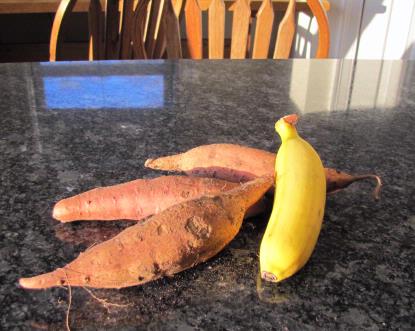A few weeks ago my sister forwarded me a clip from the fretosphere featuring a young girl who had conducted an “experiment” with sweet potatoes (http://www.youtube.com/watch?v=exBEFCiWyW0).
Our hero, Elyse, took a conventional sweet potato and placed it in water to get it to form slips (n=1). They didn’t. She tried the same with organically grown sweet potatoes from the same store and the plants grew a few sickly tendrils (n=1). She then purchased some from a local organic farmer and was quickly rewarded with shoots and roots (n=1).
This preliminary experiment was interesting, but lacked statistical significance. She repeated the protocol using a >20 tubers per treatment while controlling for CO2, humidity, day length and lumens. The potatoes were all sources from farms in the same locale and harvested on the same day. Storage conditions and growth conditions were identical. After four weeks dry matter of shoots was measured and an ANOVA was performed. Averages were compared for significance using a Student’s T-test. Not really.
The whole thing pegs the cute meter for me. Cuteness always makes me cynical. Of course a store bought sweet potato will take longer to germinate than a freshly dug one from a farm.
After turning to the internet, Elyse discovered that conventional sweet potatoes are treated with a product called BudNip. The implication is clear: if BudNip keeps sweet potatoes from making vines then you shouldn’t eat it. You should eat organic vegetables, so that you will grow healthy vines.
Elyse goes on to claim that Budnip kills animals in laboratory settings and has been shown to cause tumors. This last is a bit of a stretch, but hell it’s the internet and she’s cute as a bug’s ear.
There’s nothing wrong with her advice, we probably are better off avoiding a chemical that retards plant growth. But chlorpropham stops cell division; that’s how it works. Stopping cell division will inhibit tumor growth and not encourage it.

Of course neither conventional farmers, nor the manufacturers of BudNip are trying to kill consumers. In fact they’re trying to give consumers what we want: blemish free produce in February. We store our food in dark places in our houses which are warm and often humid. As far as a root vegetable is concerned, it’s growing time.
In aggregate, we consumers demand something nature can’t provide. Note the picture of the sweet potatoes I harvested back in September (with mini-banana for scale). Most of us wouldn’t buy these in a store.
The farmer, grocer, and biochemist help give us what we want. Perhaps Elyse is right about switching to organic foods, but we also need to adjust what we expect our food to look like out of season if we’re going to jettison the synthetic chemicals.
Furthermore, if we want someone to do the real experiment, we have to give more money to the National Science Foundation. They are the organization that funds basic research that may or may not have human health impacts. Yet their funding is steadily eroded, and thus it becomes harder for researchers to answer the questions we have about what we eat.


